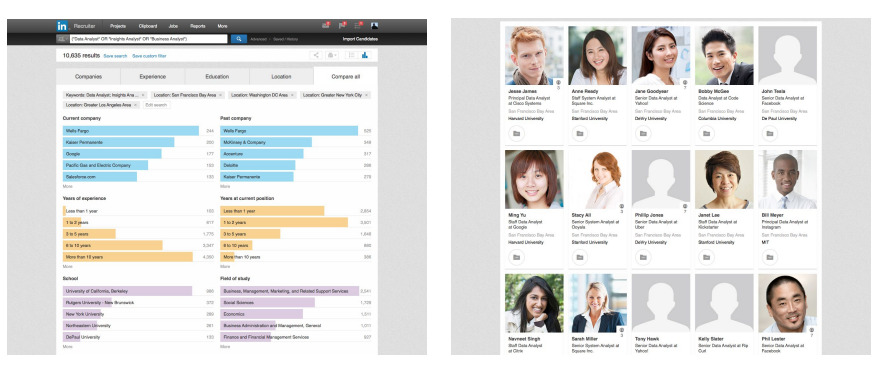Data-Driven Recruiting: The Secret for Hiring Top Talent

Talent acquisition is one field that was primarily based on guesswork until recently, in part because with candidates, a hiring manager could never really be sure if they would do a good job.
It is no surprise that close to three in four employers are affected by a bad hire today. After all, gut feeling and manual resume screening can only take you so far.
Hiring through a hit-and-miss approach can also lead to many other losses on the business side, such as increased overhead costs, an unusually long hiring process, a greater time-to-hire, unmet business deadlines, etc.
So then, where exactly does the solution to this problem lie? The answer is simple: data-driven recruiting.
“Human capital data can be leveraged to identify and hire more great people more quickly… but the vast majority of companies have yet to fully embrace data as a strategic asset in talent acquisition,” says Glen Cathey, SVP, Talent Strategy and Innovation, Kforce.
But what exactly is data-driven recruiting, and how can HR leaders leverage it to optimize a successful hiring process and gain better results? Read on to find out!
What Is Data-Driven Recruitment?
The data-driven approach to recruiting is nothing but utilizing data to optimize the complete hiring funnel at a company.
This type of recruitment process encompasses using tangible statistics and facts to make informed hiring decisions – right from shortlisting and choosing qualified candidates to formulate strong attraction and retention strategies.
Various studies have successfully depicted that hiring teams that use data have a higher probability of being more efficient, mitigating overhead costs, and improving the overall recruiting process at their organization.
Many companies don’t even realize that they have a boat-load of already existing on their recruiting systems and tools, some of which includes metrics such as:
- Percentage of bad hires
- The total cost of acquiring a new resource
- The average length of a hiring process
- Hiring source for each good employee
- Candidate referrals
- The average time it takes for a successful recruit to start performing well
- The average time each candidate takes to revert with a positive response, etc.
While there is a wealth of insight hidden in the data you deal with regularly, for the majority of employers, it simply tends to go to waste. There are, however, a lot of ways in which taking the data-driven approach to recruitment could facilitate your hiring process.
The Top 3 Benefits of Data-Driven Recruitment for Businesses
1. Improves the Overall Quality of Hires
An exhaustive report published by The Engagement Institute in 2017 states that disengaged employees cost companies in the United States up to $550 billion annually. Another recent finding by Gallup asserts that highly engaged teams show nearly 21% greater profitability.
These are just a few statistics that prove how hiring the very best candidates will considerably improve your company’s short and long-term performance.
With the same age-old, conventional hiring models, though, this can be difficult because no matter how good a candidate’s resume looks or how well they perform during the interview, this in no way guarantees they’ll be a good employee once hired.
However, leveraging data-driven recruitment can significantly increase the probability of you getting good candidates onboard your team and thus help optimize your entire hiring process.
One of the proven methodologies you can follow here is – collecting data about:
- Percentage of good hires – this includes deriving what percentage of your hires are top performers in any given department
- Turnover rate – this metric measures what percentage of your hires quit within the first few months
- Time to productivity – this metric will tell you how long does it take for a successful hire to start performing well
- Hire source – this metric discloses where your most successful hires are applying from
Once you have all the relevant data around these four metrics, all you’ve got to do is compare the first three metrics between different hire sources. That way, you will easily derive which recruitment channels are working best for your company’s specific needs.
So, for instance, you might learn that the employees you hire through referrals have a much higher productivity and low turnover rate. In such a case, you can create a better incentive for your employees that refer competent people. Or, the case might be that a specific job board gets better talent your way than the other. In that case, you can increase the budget you allocate towards the former.
2. Mitigates the Time-To-Hire and Cost-Per-Hire
Next up, data-driven recruiting can significantly help HR leaders and employers mitigate the overhead costs and the unusually long wait times associated with most conventional hiring approaches.
There are several different ways in which your recruitment team can leverage recruitment data to decrease the average time-to-hire and cost-per-hire to ensure your company’s hiring success.
In one of its recent e-books, LinkedIn presents an excellent three-step strategy to use data from your existing talent pool to hire quality candidates more effectively:
Step 1: The first step includes getting a brief overview of your target talent pool with the help of different analytic tools available in the market.
Here, it would be best if you tried to understand the different aspects of your ideal candidates, some of which include – where they currently worked, where they’ve worked before, a breakdown of their total years of experience, an analysis of the years they’ve spent in their current position, which area are they currently based out of, etc.

Source: LinkedIn
Step 2:The second step within this data-driven talent acquisition strategy involves interpreting the data from the talent pool. A few ways to do that include –
- Get competitive intelligence on which companies have the largest talent pools of people you’re interested in and prioritize recruiting from those companies. By focusing on one organization at a time, you can understand that organization’s language for a job description and save yourself time.
- Speed up your sourcing by prioritizing universities/colleges with the largest talent pools of students and alumni that meet your criteria.
- If you work for a medium to a large-sized organization, there may be internal talent that fits your qualifications and isn’t already working in the group you’re recruiting for. They may be slightly junior or the same level as the role you’re trying to fill and open to a promotion or lateral move.
Step 3: The last step suggests that you save your searches and pipeline as you move about the process because that will save you a lot of time and work in the long run.
Other than optimizing your process by using tools, you can also work on your recruitment process itself. You might realize, for example, that the first interview screens close to 70% of the total candidates. That might mean that you need an online pre-screen.
Try to work with different data sets to figure out what’s working best for your individual hiring needs, then make it into a prototype and use it more often.
3. Enhances Candidate Experience
Lastly, data-driven recruitment can help improve the pre-hire candidate experience at your company by manifolds. This is now more important than ever because the very best hires have endless options at their disposal, which is why they are off the job market within ten days .
Things only worsen if your recruiting experience is tedious and lengthy. Potential candidates might just skip over the application process altogether and move to one of your industry counterparts.
To keep a scenario like this from happening, you need to step up your game. It would be best to make it as easy for potential candidates to apply for your open positions as possible.
Some of the ways data-driven recruitment methods can help you improve your candidate experience are:
- Create more competitive job descriptions and offers by researching competent salaries and benefits. You can quickly gather these and many other relevant metrics from job boards such as Glassdoor and Payscale.
- Ensure your candidate experience is positive by conducting post-interview surveys. You can circulate a brief questionnaire through means of virtual forms and improve areas your recruitment process might be lacking based on candidate feedback.
- Use state-of-the-art techniques such as predictive analytics to gauge candidate interest in the position early on. It is nothing but the process of using historical patterns and data to make predictions about a candidate’s past hiring behavior.
Predictive analytics can help you collect and analyze data using statistics, machine learning, and modeling techniques to predict best what could happen under specific scenarios.
Apart from the ones mentioned above, there are a lot of other data-driven techniques and tools that you can leverage to enhance candidate experience at your company. One best practice to find those would be to conduct frequent market research and look at what your competitors are doing to innovate on that front.
Use Recruiting Data Today
All in all, data-driven recruitment is set to transform the way we perceive talent acquisition at present.
Even if your recruiting teams are pretty good at making decisions based on intuition, they will undoubtedly find a strong ally in data and analytics-backed hiring.
To know more about the different techniques and tools you can leverage to make your hiring process top-notch, get in touch with us at Recruiter.com! We will be happy to guide you through your entire recruitment process and help you build result-driven workplaces.
Get the top recruiting news and insights delivered to your inbox every week. Sign up for the Recruiter Today newsletter.

